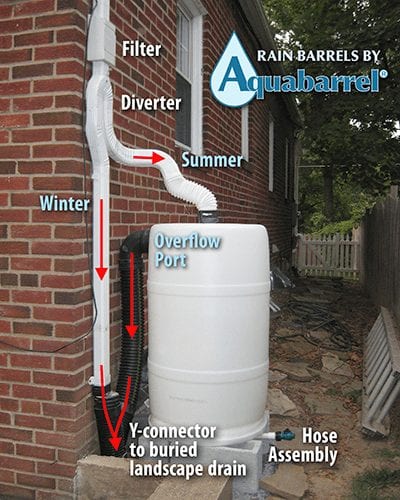Your cart is currently empty!
Rain Barrel Tips
Barrel, Basement, Frost, Gardening tools, Health, Lawn, Mosquito, Oak, Ottawa, Tea, Vegetables, Winterization
Photo:
Waldemar Brandt via Unsplash
Rain barrels are a great way to collect water to use on your lawn and garden. Here are tips on how to save on your water bill and keep water in the ground instead of the storm sewers.
Selecting a rain barrel
Consider the following characteristics when choosing a rain barrel:
- Child-safe, non-removable lid;
- Built-in, secure mosquito and debris screening; and
- Overflow and linking options (to other barrels).
Local garden supply and hardware stores are the obvious places to get a rain barrel. However, rain barrels may occasionally be obtained through local fundraising activities.
Location, location, location
Place your rain barrel near where the water will be utilised, such as cleaning the car and gardening equipment or watering the flower beds and yard. Rain barrels should be installed on a firm, flat surface. A full 200L rain barrel may weigh 200kg, or almost 400 pounds (water weight plus barrel weight).

Don’t drink the water
Rain barrel water is unsafe to drink, cook with, or bathe in. It is often gathered from a roof and can transport germs, parasites, and viruses from bird and animal excrement, as well as chemical pollutants from roofing materials. Bacterial growth can occur in the warm, dark atmosphere of a rain barrel.
Water at the Roots
Follow these suggestions for a healthy garden while watering fruits and vegetables:
- Keep rain barrel water off the leaves of edible plants and direct water into the soil around the plants instead. Drip hoses have the added benefit of slowly releasing water over time, keeping your plants well watered and making sure your barrel is ready to capture the next rain.
- Wash all vegetables with clean tap water before eating.
- Consider installing a water diverter to re-direct the first flush of roof runoff away from your barrel. This first flush of rainwater has more roof debris and contaminants that are undesirable in the barrel.
Collect the max
Drain your rain barrel after each rain event to ensure that it captures the most volume feasible; this may also aid to limit mosquito population expansion. Always steer overflows away from foundation walls and neighbouring homes to safeguard property.
Protect your investment
Rain barrels and their connections require some maintenance:
- regularly clean and maintain your eavestroughs and downspouts,
- consider adding screening and gutter guards to help keep leaves and other materials out,
- ensure connections are tight,
- clean and maintain your rain barrel annually
Winterize your rain barrel
Before the first frost, follow these simple steps to ensure that your rain barrel continues to last for years.
- Empty the rain barrel and drain hoses completely.
- Disconnect any hoses and leave the spigot open to prevent accumulation of water.
- Disconnect the rain barrel from the downspout.
- Reattach the cut portion of the downspout, or attach a temporary flexible downspout. To prevent damage, direct the downspout away from basement walls, window wells and neighbouring properties.
- Alternately consider installing a rain diverter for easy seasonal removal and re-installation.
- Store the rain barrel and its attachments in the garage or other protected area. If you must leave your rain barrel outside, place it in a sheltered area of the yard, turn it upside down and cover. This will help to protect the barrel from the elements and water accumulation.
- Clean the rain barrel and screens and check for any damage.
- Learn more about rainwater collection and health(link is external).
See more tips on how to manage rainwater and Soak it Up, Slow It Down and Keep it Clean!
Make a Rain Barrel
You can make your own DIY rain barrel
Sources
Share with Family and Friends
Featured Authors
Visit a Botanical Garden For Unique Experiences.
Comments
Logging in to comment gives you more features, but it is not required.
Subscribe
0 Comments
Oldest






